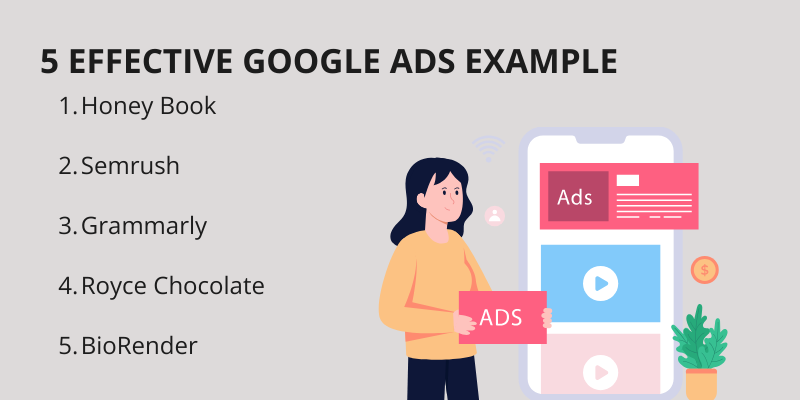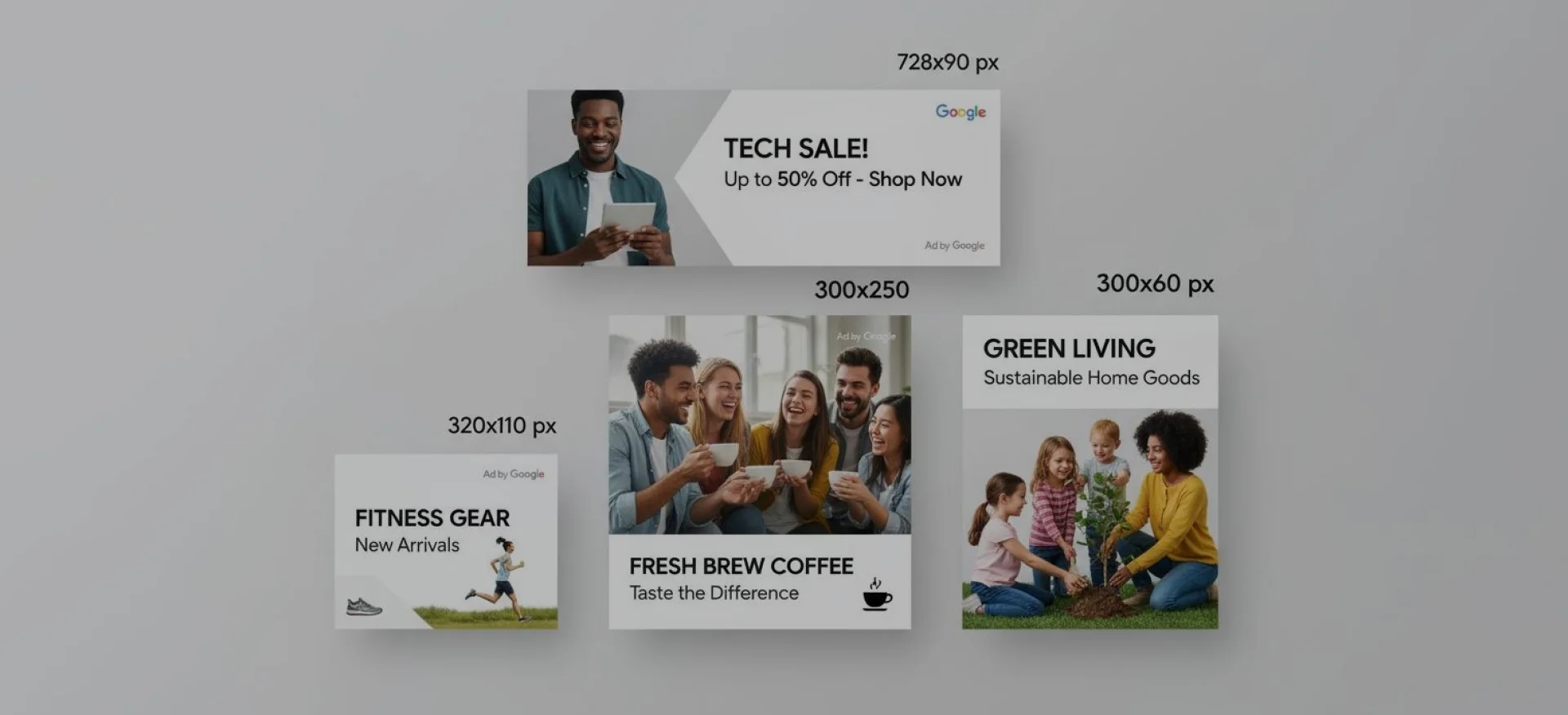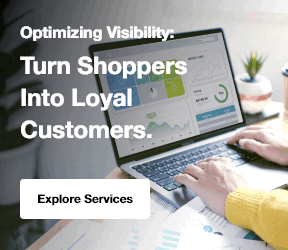Analyzing successful Google Ads campaigns can provide valuable insights into effective strategies and tactics.
For instance, Royce’, a luxury chocolate brand, utilized targeted Google Ads campaigns to drive online sales in the U.S. market, resulting in 287 conversions and over $13,600 in revenue, achieving a 225.25% return on investment.
Similarly, BioRender, a platform for creating scientific illustrations, partnered with Upgrow to enhance their Google Ads campaigns. By restructuring their account and refining targeting strategies, they achieved an 83% increase in sign-ups and a 47% reduction in cost-per-acquisition.
These Google ads campaigns examples highlight the importance of strategic planning, targeted advertising, and continuous optimization in running successful Google Ads campaigns.
These examples highlight the importance of strategic planning, targeted advertising, and continuous optimization in running successful Google Ads campaigns.
Incorporating strategies like competitor targeting, social proof, and aligning with search intent can further enhance the performance of your campaigns.
Understanding Google Ads Campaigns
A Google Ads campaign is a structured advertising initiative within Google's platform, designed to achieve specific marketing objectives.

It encompasses one or more ad groups that share common settings such as budget, location targeting, bidding strategies, and ad scheduling.
This structure allows advertisers to organize their ads effectively, ensuring that each campaign aligns with particular goals, whether it's driving website traffic, generating leads, or increasing sales.
In fact, one of the best marketing tactics retailers use is competitor targeting, which often takes up a significant part of their budget. So, what are five marketing strategies that retailers spend half of their annual budget on? including what are automated queries and their impact? Competitor bidding, targeted keyword strategies, and using strong visuals often make up a big chunk of that spend.
6 Types of Google Ads
There are several types of Google Ads campaigns, each tailored to different marketing needs:

- Search Ads: Text-based ads that appear on Google search results pages when users search for specific keywords.
- Display Ads: Visual banner ads displayed across Google's Display Network, reaching users as they browse various websites.
- Video Ads: Ads shown before, during, or after YouTube videos, ideal for brand awareness and engagement.
- Shopping Ads: Product-based ads that showcase images, prices, and business names, appearing on Google Search and Shopping platforms.
- App Ads: Ads promoting mobile applications across Google's platforms, encouraging app downloads.
- Discovery Ads: Visually rich ads that appear across Google's feeds, including YouTube, Gmail, and the Discover feed.
Analyzing the 5 Most Effective Google Ads Campaign Examples
Analyzing effective Google Ads campaign examples reveals how strategic targeting, compelling messaging, and optimized landing pages can drive meaningful results.

Some common examples are:
- Honeybook
- Semrush
- Grammarly
- Royce Chocolate
- BioRender
1. HoneyBook: Competitor Bidding with Humor
HoneyBook, a business management platform, employed a clever Google Ads strategy by bidding on the brand name of its competitor, FreshBooks.
This approach allowed HoneyBook to capture high-intent traffic from users searching for FreshBooks, effectively diverting potential customers to their own platform.
This tactic is an example of how Duckduckgo vs Google can also be seen in search engine competition when evaluating different user privacy approaches.
The ad's playful and self-aware tone acknowledged the competitor directly, showcasing HoneyBook's confidence and brand personality.
This tactic not only attracted attention but also differentiated HoneyBook in a crowded market.
Key strategies behind this campaign included:
- Competitor Keyword Targeting: By bidding on FreshBooks' brand name, HoneyBook positioned itself as a direct alternative, reaching users already considering similar solutions.
- Engaging Ad Copy: The ad's humorous tone made it stand out in search results, increasing click-through rates and user engagement.
- Use of Sitelinks: HoneyBook utilized Google's sitelink extensions to provide additional links to relevant pages, enhancing the ad's visibility and offering users more options to explore.
- Brand Personality: The playful acknowledgment of bidding on a competitor's keyword conveyed confidence and a sense of humor, humanizing the brand and making it more relatable to potential customers.
Explore Our Digital Marketing Services!
2. Semrush: Targeting "Alternatives" Keywords
Semrush, a leading SEO tool provider, strategically targeted users searching for "X alternative" by bidding on keywords like "SEMrush alternative."
By doing this, Semrush reached users actively evaluating similar tools. This strategy is related to Google keyword ranking, as bidding on competitor terms like "X alternative" also strengthens your ranking in relevant search results.
This approach allowed Semrush to capture high-intent traffic from users actively considering alternatives, effectively positioning itself as a compelling option.
The ad copy emphasized the unique benefits and features of Semrush, differentiating it from competitors and addressing potential customers' needs.
Key Strategies include
- Competitor Keyword Targeting: By bidding on competitor brand names and "X alternative" keywords, Semrush reached users in the consideration phase, who were actively evaluating similar tools.
- Highlighting Unique Selling Points: The ad copy focused on Semrush's comprehensive features and advantages over competitors, providing a clear value proposition to potential customers.
- Optimized Landing Pages: Clicking on the ad directed users to a landing page that detailed the benefits of choosing Semrush over alternatives, reinforcing the ad's message and encouraging conversions.
3. Grammarly: Emotional Storytelling on YouTube
Grammarly's YouTube ad campaign featured a compelling narrative about a father writing to his daughter, emphasizing the emotional impact of using their writing assistant.
The ad's storytelling approach resonated with viewers, leading to increased engagement and brand recall.
This strategy highlights the effectiveness of emotional storytelling in advertising, demonstrating how connecting with audiences on a personal level can enhance the impact of a brand message.
Key Strategies for this campaigain include:
- Emotional Storytelling: By focusing on a heartfelt narrative, the ad created an emotional connection with viewers, making the message more memorable.
- Relatable Characters: The portrayal of a father expressing his feelings to his daughter made the story relatable to a broad audience, enhancing its appeal.
- Subtle Product Integration: Grammarly was seamlessly integrated into the story, showcasing its benefits without detracting from the emotional core of the narrative.
- High-Quality Production: The ad's professional production values ensured a polished presentation, reinforcing the brand's commitment to quality.
4. Royce' Chocolate: E-commerce Success
Royce’, a renowned Japanese chocolate brand, partnered with LYFE Marketing to enhance its online presence and drive sales in the U.S. market.
Through a targeted Google Ads campaign, Royce’ achieved impressive results, including 287 conversions and over $13,600 in revenue, yielding a 225.25% return on investment (ROI)
Key Strategies include:
- Targeted Keyword Selection: LYFE Marketing conducted thorough keyword research to identify high-intent search terms relevant to Royce’s products. By focusing on specific keywords, they ensured that the ads reached users actively searching for premium chocolates.
- Optimized Ad Copy: The ad copy was crafted to highlight Royce’s unique selling points, emphasizing the quality and exclusivity of their chocolates. Clear calls-to-action were included to encourage immediate purchases.
- Strategic Budget Allocation: A well-planned budget was allocated across various campaigns to maximize visibility and conversions. Continuous monitoring allowed for adjustments to optimize performance and ensure cost-effectiveness.
- Compelling Visuals: High-quality images of Royce’s products were used in the ads to attract attention and showcase the premium nature of the chocolates.
5. BioRender: Optimizing B2B Lead Generation
BioRender, a platform specializing in scientific illustrations, partnered with Upgrow to enhance their Google Ads campaigns.
By restructuring their account and refining targeting strategies, they achieved an 83% increase in sign-ups and a 47% reduction in cost-per-acquisition.
This approach allowed BioRender to effectively reach their target audience and drive meaningful conversions. The integration of performance marketing tactics helped maximize the return on ad spend.
Key Strategies include
- Focused Campaign Structure: Upgrow segmented BioRender's campaigns based on core offerings and audience types, tailoring budgets according to market profitability data. This segmentation ensured that each campaign was aligned with specific goals and target demographics.
- Improved Ad Relevance: The ad copy was refreshed to resonate with BioRender's audience, emphasizing key benefits and aligning messaging with search intent. This alignment improved Quality Scores and reduced costs, leading to more effective campaigns.
- Smart Bidding Strategies: Implementing Target CPA bidding allowed for efficient scaling of campaigns while controlling costs. Regular search query reviews ensured that irrelevant traffic was eliminated, preserving the budget for high-value customers.
- Landing Page Optimization: BioRender's landing pages were optimized to improve conversion rates. Dedicated landing pages for each ad group ensured that users were directed to relevant content, enhancing user experience and increasing conversions.
Explore Our Performance Marketing Services!
4 Best Practices For Google Ads Campaign Optimization
Optimizing your Google Ads campaigns is essential for maximizing return on investment (ROI) and achieving your marketing objectives. Implementing best practices can significantly enhance the effectiveness of your campaigns.
Many digital marketers ask how to measure brand awareness, which is key for tracking campaign success.
1. Keyword Research
Focus on long-tail keyword phrases that are more specific and less competitive. These often lead to higher conversion rates as they capture users with clear intent. Utilize tools like Google Keyword Planner to identify relevant keywords and analyze search volume and competition.
2. A/B Testing
Regularly test different versions of your ads and landing pages to determine which elements resonate best with your audience. For example, experiment with varying headlines, calls to action, or visuals to see what drives higher engagement and conversions. Ensure that each test isolates a single variable to accurately assess its impact.
3. Negative Keywords
Implementing negative keywords is crucial to prevent your ads from showing for irrelevant searches, thereby saving your budget and improving ad relevance. Regularly review your search term reports to identify and add negative keywords, such as "free" or "jobs," that do not align with your offerings.
4. Quality Score
Google's Quality Score affects your ad rank and cost-per-click. To improve it, ensure that your ad copy is relevant to the keywords, your landing page provides a good user experience, and your ads have a high click-through rate. A higher Quality Score can lead to better ad positions at lower costs.
Measuring Success: 4 Key Google Ads Metrics
To evaluate the effectiveness of your Google Ads campaigns, it's essential to monitor key performance indicators (KPIs) that align with your business objectives.
These metrics provide insights into user engagement, cost efficiency, and overall return on investment (ROI).
If you want to understand how Centric might track user behavior across multiple platforms, consider looking at these metrics.
Here are the most common metrics you must track:
1. Click-Through Rate (CTR)
CTR measures the percentage of users who click on your ad after seeing it. A higher CTR indicates that your ad is relevant and engaging to your target audience. For instance, the average CTR across industries in 2023 was approximately 6.11%
2. Cost Per Click (CPC)
CPC represents the amount you pay each time a user clicks on your ad. It's a critical metric for budgeting and assessing the cost-effectiveness of your campaigns. In 2023, the average CPC was $4.22 across various industries.
3. Conversion Rate
This metric indicates the percentage of users who take a desired action (such as making a purchase or filling out a form) after clicking your ad. A higher conversion rate suggests that your landing page and ad messaging are effectively aligned with user intent.
4. Return on Ad Spend (ROAS)
ROAS measures the revenue generated for every dollar spent on advertising. A higher ROAS indicates a more profitable campaign. For example, a ROAS of 6 means that for every $1 spent, $6 in revenue is generated.
Frequently Asked Questions
What makes a Google Ads campaign effective in 2026?
An effective Google Ads campaign in 2025 focuses not just on the ad itself, but also on the user’s entire journey — from the search result to a landing page that converts. This means using clear, intent‑matching keywords, compelling ad copy, and a landing page that delivers what the ad promises (fast loading, relevant offer, clear call‑to‑action).
What types of Google Ads campaigns work well in 2026?
In 2025, ads across several formats — including Search ads, Shopping ads, Video (e.g., YouTube bumper ads), Display ads, and full‑funnel Google Ads “Performance Max” campaigns — can all perform well depending on your goal. Choosing the right type depends on your objectives: driving traffic, leads, sales, or brand awareness.
How can I use social proof and offers to boost ad performance?
Showing social proof (like reviews, trust signals, or ratings) and offering incentives (e.g., discounts, free trials, limited‑time deals) in your ad copy helps reduce buyer hesitation and increase conversions. Ads that clearly highlight how they solve user pain points and offer value tend to get higher click-through and conversion rates.
Why is matching ad copy to search intent important for a Google Ads campaign?
Ads that align with what users are searching — whether they want information, a product, or a service — perform better. Matching ad copy and landing pages to search intent (informational, navigational, transactional) ensures relevance and improves user experience, which leads to higher conversion rates.
How can combining ad formats help improve results for Google Ads campaigns?
Using a mix of ad formats — such as text Search ads for high‑intent queries, video ads for brand awareness, and Shopping or Display ads for visual appeal — helps reach users at different stages of their buying journey. A diversified campaign strategy can increase reach, engagement and conversions across multiple touchpoints.
Conclusion
In this blog, we've explored the essential components of crafting and optimizing Google Ads campaigns to achieve measurable success.
Key strategies include defining clear objectives, conducting thorough keyword research, segmenting your audience, optimizing landing pages, and continuously monitoring and adjusting campaigns based on performance data.
By reviewing Google ads campaigns examples, marketers can better understand how to implement effective strategies in their own campaigns.
Additionally, integrating Google Ads with Google Analytics provides deeper insights into user behavior, enabling more informed decision-making.









